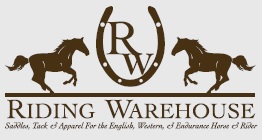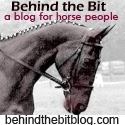 Over the weekend I visited a boarding barn in the area and was unlucky enough to witness an accident in a round pen. While it turned out okay as far as I know, it could easily have ended in tragedy.
Over the weekend I visited a boarding barn in the area and was unlucky enough to witness an accident in a round pen. While it turned out okay as far as I know, it could easily have ended in tragedy.
The story begins...
I was visiting my friend Lori, who boards her horse Eli at a farm about 5 miles from where I board Riley. Several horses at this farm, including Eli, are on layup. To preserve their sanity each gets a few hours in a small portable "tubular type" round pen every day. I'm told this has been a practice for years, but recently the pen was moved to an area between two pastures.The pen is a foot from the pastures on either side, and two or three horses are turned out in these adjacent pastures.
Eli was in the round pen when I arrived. I noticed that he was playing with another horse over the fence -- nothing that seemed too serious -- squealing, halter tag, and nipping. After a fashion Lori went to talk to someone riding in the indoor, which was some distance from the barn. Standing in the aisle of the barn, I had a view of the round pen.
 I saw Eli and the horse on the other side of the fence both rear -- Eli went pretty high up -- and something about the way he landed made me do a double-take. I walked closer, but could not tell what seemed so strange. It didn't look right. I started to jog and as I got nearer, I saw the problem. Eli had caught his right foreleg on the top of the fencing. His pastern was firmly wedged in the fence just above where the fences are pinned together (see photo). His left front leg was just barely touching the ground. He was standing fairly quietly as I approached. His leg was at an unnatural upward angle and his scapula was pulled back hard. Much of his weight appeared to rest on that right leg. He would periodically lean back as if try to pull his leg free.
I saw Eli and the horse on the other side of the fence both rear -- Eli went pretty high up -- and something about the way he landed made me do a double-take. I walked closer, but could not tell what seemed so strange. It didn't look right. I started to jog and as I got nearer, I saw the problem. Eli had caught his right foreleg on the top of the fencing. His pastern was firmly wedged in the fence just above where the fences are pinned together (see photo). His left front leg was just barely touching the ground. He was standing fairly quietly as I approached. His leg was at an unnatural upward angle and his scapula was pulled back hard. Much of his weight appeared to rest on that right leg. He would periodically lean back as if try to pull his leg free.
Trying to avert a crisis
Knowing Lori would not hear me, I yelled the name of a young girl (Wendy) I had just met who was tacking up her horse. I pushed the fencing toward Eli, trying to lower it so he could more easily pull it out. I went between the fences and tried to push up on the hoof, but it was too deeply wedged to free. Wendy came running and i asked her to find someone who could help move the fence. Believe me when I tell you that I am useless in a real crisis situation. But because Eli was calm, I could be fairly calm. I figured we would need to dismantle the pen, and I tried to see how this could be done. The panels were held together with pins that were likely jammed from the weight of Eli and bolted chains. It didn't look very hopeful.
In short order, the barn manager came out, wielding bolt cutters. As he approached, Eli apparently decided the best course of action was to raise his upper body (rear) -- clever boy! He was trying to get out of his predicament the same way he got in it. On his first attempt, he tried to use his other leg to climb up the panel and got his other front leg caught between the rails. My heart sank. Now he was on his hind legs with both front legs caught. The barn manager asked me if I was ready for him to cut the chain. I said yes, not knowing just what I was ready for. Just as he was positioning the cutters, Eli lifted himself again and got free. When he landed he put weight on both legs, moving a little tenderly. The manager took him back to the barn, and closer examination showed some cuts/gouges but no major arteries or tendons hurt.
Is it just me, or did something bad just happen?
Lori was summoned to attend to her horse, but she was only told he cut himself on the fence. A few minutes later Wendy, Lori, and the manager were chatting casually while Lori hosed Eli's leg. I stood off to the side, quietly having a post-traumatic stress reaction. If anyone else was reflecting on how narrowly Eli had escaped a serious injury, it was not apparent from their demeanor. Maybe I should cut them some slack, I thought. It is tough to judge someone's feelings based on outward appearances. Then the barn manager excused himself to do the afternoon turnout. As I watched, he put out another group of horses in the same configuration -- another horse went in the round pen and horses were turned out in the adjacent pastures. The effort of keeping my mouth shut made my throat hurt. I had expected the manager to turn to us and say, "help me dismantle this thing and take it to the dumpster." But instead he turns more horses out. So much for risk avoidance.
Yes, Eli is okay. But what if he had panicked? What if he had fought? If he had leaned either direction -- well, legs don't bend that way. What if he had fallen? To me, this was a real life drama, and Eli was a champ! If he had not been so sensible, he might severed an artery or broken a leg, and we'd be getting a backhoe, not leg wraps and betadine. We all should have been hugging Eli and saying "Good Boy!"
Portable round pens: A safety issue?
In googling for more information about (portable) round pen safety I found no substantive articles on the subject. Not one. A lot of round pen ads make references to "safer construction." More telling, I found many anecdotes on bulletin boards like this a Horsetopia bulletin board posting that described the same kind of accident Eli had...
" A friend of mine had a severe accident with her horse not too long ago--he was turned out in an area that she had her round pen and he decided to try to jump INTO it....LORD ONLY KNOWS WHY....but she had a round pen with pins, so there was a space between the panels and when the horse reared to jump the panel his hoof slid inbetween the panels and got stuck, of course he paniced (this was an 18 hand draft horse) cut an artery, blood everywhere, round pen totalled...it was a mess. Horse was fine, but it was a mess. If they would've had chains, bolt cutters would've gotten him out a lot quicker than trying to pry the pins out."
You can also buy
panel caps to cover the gap in round pen panels constructed like the one that injured my friend's horse...

The takeaway message about portable round pens is, they ain't all that safe. Some are constructed better than others, but I would not leave a horse unattended in in a metal structure with gaps for legs, heads, or hooves to get caught. At least, not any more.
 Note: It takes me a while to get to my point here. Bear with me! A dear friend of mine has a lovely arab/quarter horse cross, about 15 hands high, named Chuckie. He's among the sturdiest, most sensible animals I know. My friend Patrice loves him fiercely, and like many owners (including me, I suppose) she tends to romanticize Chuck. In fact, she doesn't seem to see the same horse the rest of us see. What do I mean?
Note: It takes me a while to get to my point here. Bear with me! A dear friend of mine has a lovely arab/quarter horse cross, about 15 hands high, named Chuckie. He's among the sturdiest, most sensible animals I know. My friend Patrice loves him fiercely, and like many owners (including me, I suppose) she tends to romanticize Chuck. In fact, she doesn't seem to see the same horse the rest of us see. What do I mean?



































